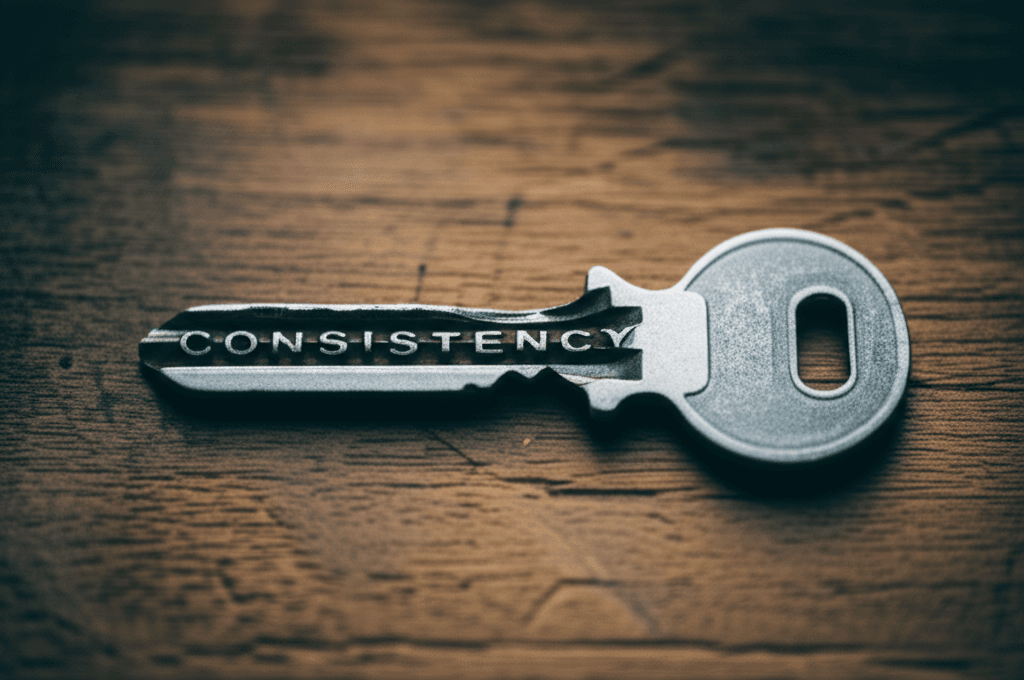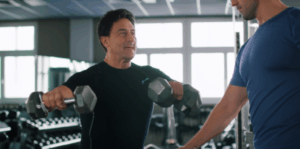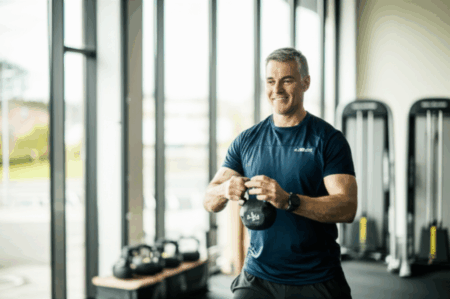Are you tired of endless cardio and restrictive diets that yield minimal results? Do you dream of shedding stubborn fat, boosting your energy, and even turning back the clock on your biological age? The answer might be simpler and more effective than you think: a strategically designed, intense workout just three times a week. This “killer workout” approach isn’t just a trend; it’s a science-backed method for fat loss and a powerful anti-aging tool that can leave people questioning your real age.

The Science Behind High-Intensity, Infrequent Training
The effectiveness of an intense, three-times-a-week workout regimen lies in its ability to optimize your body’s physiological responses for both fat loss and cellular rejuvenation. This approach often combines elements of High-Intensity Interval Training (HIIT) and strength training, which collectively trigger a cascade of beneficial effects.
Turbocharging Your Metabolism: The Afterburn Effect
One of the primary reasons “killer workouts” are so effective for fat loss is their impact on your metabolic rate. High-intensity exercise, particularly HIIT, leads to a phenomenon known as Excess Post-Exercise Oxygen Consumption (EPOC), often called the “afterburn effect.” This means your body continues to burn calories at an elevated rate for hours, and sometimes even up to 48 hours, after your workout is complete, as it works to recover and restore oxygen levels. Studies show that this post-exercise calorie burn is significantly more pronounced with HIIT compared to moderate-intensity continuous training.
Beyond the immediate afterburn, building lean muscle mass through strength training further boosts your resting metabolic rate (RMR). Muscle tissue is more metabolically active than fat, meaning the more muscle you have, the more calories your body burns at rest, making long-term fat loss more sustainable.
Hormonal Harmony for Fat Loss
Intense exercise regimens also positively influence hormonal balance, which is crucial for weight management. HIIT, for instance, can increase fat-burning hormones like growth hormone and adrenaline, which are vital for breaking down fat and preserving muscle mass. Regular physical activity can also improve insulin sensitivity, helping your body regulate blood sugar levels more effectively and shifting fuel utilization away from carb-burning towards fat-burning. While intense exercise can acutely raise cortisol, a stress hormone, the overall long-term benefits of consistent training on metabolic health and hormonal regulation often outweigh this, especially when balanced with adequate recovery. Resistance training has also been shown to improve testosterone production, a hormone important for muscle tone and bone density in both men and women.
Cellular Rejuvenation: Defying Biological Age
The “killer workout” isn’t just about looking good; it’s about feeling and being younger at a cellular level. Research into telomeres, the protective caps on the ends of chromosomes, suggests a direct link between high levels of physical activity and slower cellular aging. Studies have found that adults with consistently high physical activity levels have telomeres with a biological aging advantage of up to nine years over those who are sedentary, and a seven-year advantage compared to those who are moderately active. While the exact mechanism is still being explored, it’s thought that exercise helps by suppressing inflammation and oxidative stress, both of which are linked to telomere shortening. More recent research has also indicated that short bursts of high-intensity exercise can reduce biological age by nearly 3.6 years by affecting molecular gene expression.
Strength training, specifically, is considered one of the most effective tools to slow or even reverse many negative effects of aging, including improving bone density, hormone health, cognitive function, and skin health. It helps combat sarcopenia, the age-related loss of muscle mass, preserving existing muscle and stimulating new growth, even in individuals over 70.

Crafting Your 3-Day “Killer Workout” Routine
The key to a successful three-day-a-week program is to incorporate full-body movements that maximize muscle activation and calorie burn. Combining strength training with bursts of high-intensity cardio, or incorporating elements of HIIT into your strength sessions, can be highly effective.
Essential Components of Your Weekly Plan
- Full-Body Strength Training: Dedicate your three workout days to compound exercises that work multiple muscle groups simultaneously. This maximizes efficiency and metabolic response.
- High-Intensity Intervals (HIIT): Integrate HIIT either as part of your strength workouts (e.g., supersets, circuits, or finishers) or as short, separate cardio sessions on non-lifting days if time allows.
- Active Recovery: On your rest days, engage in light physical activity like walking or stretching to aid recovery and boost overall daily calorie expenditure. Aim for 10,000 steps daily.
Sample 3-Day Workout Structure
While specific exercises can vary based on individual fitness levels and equipment availability, here’s a general framework for a “killer workout” split:
- Day 1: Full Body Strength (Push Focus)
- Warm-up: 5-10 minutes of light cardio and dynamic stretching.
- Compound Lifts: Bench Press (or Dumbbell Incline Press), Squats (or Leg Press), Overhead Press (or Dumbbell Push Press). Aim for 3-4 sets of 5-10 repetitions for heavier lifts, or 8-12 reps for muscle growth, ensuring challenging weights.
- Accessory Exercises: Incline Dumbbell Press (for upper chest), Triceps extensions, Lateral Raises.
- Core Finisher: Plank (hold for 30-60 seconds, 2-3 sets) or Leg Raises.
- Day 2: Active Recovery
- Light walk (30-60 minutes) or gentle stretching/yoga.
- Day 3: Full Body Strength (Pull Focus)
- Warm-up: 5-10 minutes of light cardio and dynamic stretching.
- Compound Lifts: Deadlifts (or Romanian Deadlifts), Bent-Over Rows (or TRX rows), Pull-ups (or Lat Pulldowns).
- Accessory Exercises: Bicep Curls, Face Pulls (for rear delts and upper back).
- Core Finisher: Russian Twists or Mountain Climbers.
- Day 4: Active Recovery
- Light walk or cycling.
- Day 5: Full Body Strength (Legs/Full Body Circuit Focus)
- Warm-up: 5-10 minutes of light cardio and dynamic stretching.
- Compound Lifts: Lunges (or Bulgarian Split Squats), Kettlebell Swings (excellent for glutes/hamstrings and cardio), Step-ups.
- Circuit Training (incorporating HIIT elements): Choose 3-5 exercises (e.g., Burpees, Box Jumps, Ball Slams, Dumbbell Thrusters, Rowing Machine Sprints). Perform each exercise for 30-45 seconds at high intensity, followed by 15-30 seconds of rest. Complete 3-5 rounds.
- Core Finisher: Hanging Leg Raises or Abdominal Roll Outs.
- Day 6 & 7: Rest or Light Activity
- Prioritize sleep and recovery. Light walking is always beneficial.
For those new to high-intensity training, it’s advisable to build up gradually. Beginners can start with moderate-intensity steady-state cardio before progressing to HIIT. Bodyweight exercises can also be highly effective, even if you don’t have access to a gym.

The Crucial Role of Nutrition and Recovery
While a killer workout routine is a powerful catalyst, its effectiveness for fat loss and anti-aging is multiplied when combined with smart nutrition and adequate recovery.
Fueling for Fat Loss
- Calorie Deficit: To lose fat, you must consume fewer calories than you expend.
- High Protein Intake: Prioritize protein at every meal. High protein intake increases satiety, boosts your metabolic rate, and helps preserve muscle mass during fat loss.
- Complex Carbohydrates: Provide sustained energy for your workouts with whole grains, fruits, and vegetables.
- Healthy Fats: Include sources like avocado, nuts, seeds, and olive oil, which are crucial for hormone production and overall health.
- Hydration: Drink plenty of water throughout the day.
- Pre- and Post-Workout Nutrition: Consume a balanced snack or meal with carbohydrates and protein 1-3 hours before your workout for energy, and refuel within an hour after your session to aid muscle recovery.
The Power of Recovery
Rest days are not optional; they are crucial for muscle repair, growth, and preventing burnout. Overtraining, especially with high-intensity workouts, can lead to elevated cortisol levels, which can negatively impact metabolism and hinder fat loss. Aim for 7-9 hours of quality sleep per night, as it’s essential for hormonal regulation, including growth hormone production, which plays a role in fat metabolism.

Consistency is Key
The journey to fat loss and defying age is not about perfection, but consistency. Committing to three intense workouts a week, coupled with mindful nutrition and dedicated recovery, creates a powerful synergy that transforms your body from the inside out. You’ll not only see the numbers on the scale change and your physique transform, but you’ll also likely experience improved energy, mood, and cognitive function. The “killer workout” isn’t just a fitness routine; it’s a lifestyle shift that can make people truly question your age.







